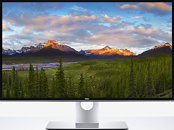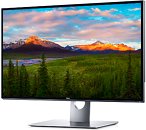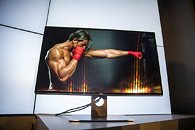Friday, January 6th 2017

Dell Unveils 32", 8K UltraSharp Monitor
At CES 2017, Dell has unveiled yet another addition to their monitor product line, and this one is drool worthy: an 8K, 32" UltraSharp monitor, with an insanely high resolution of 7,680 x 4,320 at 60Hz. Labeled as the world's first 32-inch 8K resolution display with Dell PremierColor, the UP3218K offers 1.07 billion colors and packs in more than 33 million pixels - four times as many as a 4K display and 16 times more than Full HD. That means it offers a PPI rating of 280 - which translates into "very high" settings for a desktop screen.The display covers 100 percent of the Adobe RGB and sRGB color gamut, offers a brightness of 400 cd/m2 and has a contrast ratio of 1,300:1. Connectivity options include 2x DisplayPort 1.3 connections, 4x USB 3.0 ports (1x BC1.2 charging capability) and an audio line-out connection.
Now if you ignore the fact that Windows scaling doesn't work that well, and that having to upscale your desktop to make any real use of this display on a normal desktop environment basically defeats the purpose of having it in the first place, you can probably convince yourself that you need this piece of technology right away. But then, you also have to consider that buying this monitor will have you selling all two of your kidneys, and you'd probably have to find another one somewhere else (it comes with a price-tag of $4,999 when it goes on sale on March 23). Also do the math on the serious, serious hardware you'd need just to drive any real games at this 8K resolution, and... You get the picture.
This is an amazing, sleek-looking proof of concept, but it's probably still too early for any serious adoption of this kind of display technology.. That said, someone has to push the game forward, and Dell has at least proven they can do it.
Source:
Techspot
Now if you ignore the fact that Windows scaling doesn't work that well, and that having to upscale your desktop to make any real use of this display on a normal desktop environment basically defeats the purpose of having it in the first place, you can probably convince yourself that you need this piece of technology right away. But then, you also have to consider that buying this monitor will have you selling all two of your kidneys, and you'd probably have to find another one somewhere else (it comes with a price-tag of $4,999 when it goes on sale on March 23). Also do the math on the serious, serious hardware you'd need just to drive any real games at this 8K resolution, and... You get the picture.
This is an amazing, sleek-looking proof of concept, but it's probably still too early for any serious adoption of this kind of display technology.. That said, someone has to push the game forward, and Dell has at least proven they can do it.



67 Comments on Dell Unveils 32", 8K UltraSharp Monitor
This is some serious business.
I didn't expect to see 8K Monitors in 2017, but I would want one please!
Even just to watch my cursor in all its glorious 8K goodness
I want one, and I want it 4 years ago.. now to find 5k to drop on it...
But hey, i realy like the design of it, hope other, less extreme monitors also gets it.
Guess its a IPS panel?What task bar?
according to Wikipedia DP 1.4 should support 8K 60 Hz over one cable.
Edit: Holy Shit, HDMI 2.1 can do 10K @ 120Hz!! Finally we have a cable that can deliver.
As for DP1.4, it's not really relevant: it doesn't increase bandwidth over DP1.3 (still 25.92Gbit/s usable). Meanwhile, 7680x4320x30@60Hz (59.72Gbit/s) (I'm taking 10bpp/30-bit colour space, cause professional screen with wide-gamut generally are 10bpp) still exceeds the bandwidth of 2 cables without any timing data. I suspect they're probably gonna "overclock" the interface a bit to get there, assuming nV and AMD allow them to do it.Not without any kind of compression mode it can't. Not even if you reduce it down to only 8bpp, cause with timing info, that's 49.65gbit/s which exceeds HDMI's 48gbit/s cable. Unless ofc HDMI is underrating their spec or has new timing modes,, the former I'd be impressed if they did because a bigger number would be better for marketing, and the latter they have not talked about.
EDIT:lolnope. 10K at 120Hz at 24bpp (188.74gbit/s) then chroma subsampled down to 4:2:0 is a "mere" 94.37gbit/s, well beyond what the 48gbit/s cable can deliver.
1920 eh almost 2000, so we'll call it 2k (only 80 off)
3840 eh almost 4000 so we'll call it 4k (only 160 off)
7680 eh almost 8000 so we'll call it 8k... (only 320 off)
by the time we get to 16k
15360 eh almost 16000 so we'll call it 16k ("only" 640 off...pretty much 15k at this point)
32k
30,720 eh almost 32,000 (dude you didn't even make 31k)
Still though 4k hasn't really made it to mainstream yet. Streaming content is minimal, highend gaming rigs can barely keep up and people have stopped obsessing about megapixels on their digital cameras. They now go for better lenses, and things that will actually improve the quality of the shot rather than going straight for a 32 megapixel camera that has a shutter speed too slow to catch a blink.
So cool developers can now use this for art projects...not exactly the largest market there.
The only reason i see is because of cost production.
Although 3 x Vega 10 should run 8K quite well in the games that support crossfire.
PS: for reference, my 30" 2560x1600 is 100ppi, and my 24" 1920x1200 is 94ppi.
1080p on your screen will looks fuzzy because it is not a whole number:1 ratio of pixels. whereas 900p is 4:1
Yet I remember people telling me it took a 50" screen to tell the difference between 720p and 1080p. Now they say the same thing with 4K. Just like 144 vs 120 vs 60 fps - the peasant arguments will never end.
Better is better, and it is easy to tell the difference. If you can't tell the difference - well I am sorry then you have terrible eyesight.
For the record, I owned an HTC 10, that had a 2560x1440 screen in the same 5.2" size as the 1920x1080 in my Xperia Z2, and it improved nothing for what I use my phone for (primarily IM and reddit). Sadly, the HTC's firmware had an annoying number of niggles, so I sold it on and went back to my now quite old Z2 despite the performance improvement in places.